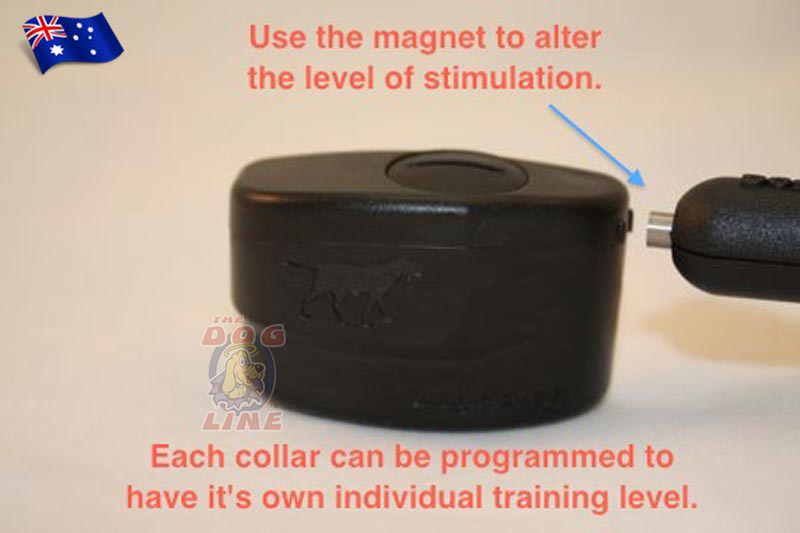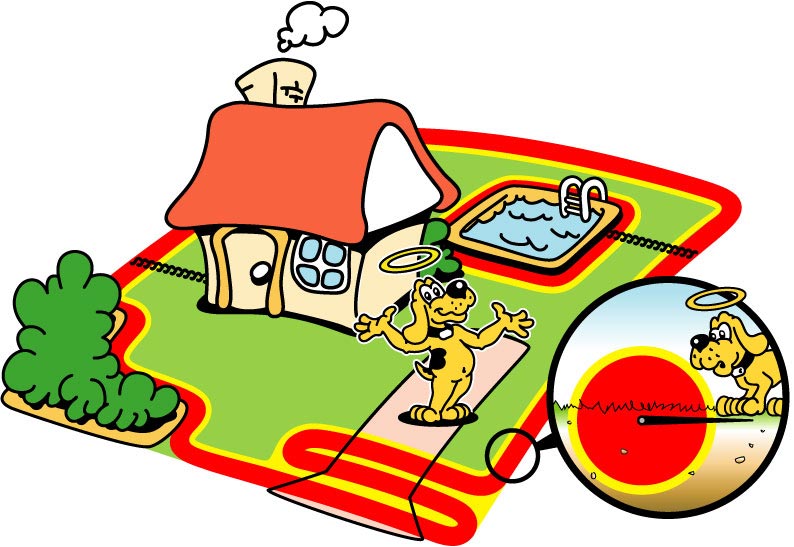This dog fence collar burnt my dog’s skin - the truth behind the issue. Does the dog fence collar really create burns on a dog’s skin? Collar Fit and Pressure Necrosis.
The Dog Fence Collar Burnt My Dog’s Skin - Fact or Myth?
We see it all over the internet - this dog fence collar burnt my dog’s skin. Is it really caused by the Electric Dog Fence equipment failure and burning? Or… A result of forgetting to check, and monitor the contact points that touch the dog’s skin? Taking care of your dog’s hygiene will reduce and even eliminate the occurrence of a Pressure Necrosis.
Necrosis - The death of most or all of the cells in an organ or tissue due to disease, injury, or failure of the blood supply From Necro (meaning Dead) and osis (of the ‘skin’)
Pressure Necrosis or what we commonly call ‘Collar Sores’ develop when the collar is fitted too tight or is left on for an extended period on your dog’s neck. The constant pressure and friction from a tight collar can cause chronic trauma to a dog’s skin and subcutaneous tissue.
Should this pressure create a sore or wound - it can quickly become infected and start to spread to other areas around the neck. It is obviously very sore and painful for the dog… which can be displayed in a change in the dog’s temperament - ranging from a mild mood swing to sudden and out of character aggression.
These wounds are very unsightly and can become a very serious bacterial infection that will need veterinary attention and time to heal.
Is The Electric Dog Fence ‘Zap’ to blame?
Unfortunately, this type of condition has cast a dark cloud (which is unwarranted) over the Electronic Dog Training industry as a whole.
The implication is that the electronic stimulation from an electric dog fence collar is the actual cause of this type of condition.
And i will say that there are many ‘Haters’ that have used the occurrence of a pressure Necrosis (Collar Sore) as some form of ammunition against the Electric Dog Fence industry as a means to deter people from using them.
Is the risk of a Collar sore worse than the risk a dog, and it’s owner faces - if a dog escapes? Nup!
Our Dog Fence Collars - Do Not burn a dog’s skin.
To set the record straight these are not BURNS! But sores and later infection that are caused by prolonged wear and rubbing - these don’t happen overnight and they can be avoided quite easily.
The electric zap collar does not produce heat - to burn a dog's neck.
 Burns in the terms of heat… People must understand that the generated milliamps from these radio fence collars simply cannot generate enough heat to create burns (in a heat sense of the word).
Burns in the terms of heat… People must understand that the generated milliamps from these radio fence collars simply cannot generate enough heat to create burns (in a heat sense of the word).
Given the fact that an electric fence receiver collar produces only 2% of the heat output needed to create the burn. It is unlikely that a burn is what is being experienced on your dog’s skin.
Moreover, it’s not the static stimulation from a dog fence collar that causes these so-called ‘burns’ - but rather the irritation that is caused by friction from the improper collar use that results in collar sores - and infection.
Avoid buying cheap quality dog fence kits to prevent collar sores
There is no need to have a dog fence collar done up too tight if you get the right one.
Our Dog Fence Collars have three aerials inside the collar, it will still activate even if it moves to the side of the dog’s neck - so keep it loose but just touching the skin for connection. There is NO NEED to do our collars uptight.
A collar with a single aerial may not pick up the signal - if it is out of alignment and sideways - so people tend to do them up tight to keep them from moving (and so, increase the chances of a burn or pressure necrosis on the dog’s skin and neck)
“Some dogs have even been known to try and turn their heads sideways to see if the collar will react as they reverse through the signal”
Safety shutdown features in electric dog fence collars.
It means what it says - if a collar stays in the radio signal and zaps the dog it MUST have a safety shut down where the collar will STOP the zap. And this is usually set to a very short period of time.
For example, our dog fence collar will shut down and go to beeping only after only 20 seconds in the radio signal. The collar will beep and then give a quick ‘stim’ every 20 seconds.
The reason is not for concern of burning or affecting the skin - the reason for this is in case the dog becomes disoriented it has time to move away. Quite frankly if a dog is trained correctly then the need for a safety shutdown feature should never arise.
The Zap levels in the Dog Collar and fast reaction times to stop the dog escaping.
 Ok, so you bought a dog fence collar and the dog is still getting out. The advice is to tighten the collar so it makes a better connection with the skin right?... well yes but there are other factors at play here.
Ok, so you bought a dog fence collar and the dog is still getting out. The advice is to tighten the collar so it makes a better connection with the skin right?... well yes but there are other factors at play here.
What is happening in the training may have failed and the dog has decided to put up with the zap and run through.
Tightening the collar will increase what the dog feels and may prevent future run through but it will definitely increase the chances of pressure necrosis and collar sore.
Slow reaction time on the collar will also increase the odds of the dog running through. So get a collar with levels you can change to make the training more effective, and super-fast reaction time so the dog can’t just skip across the line to freedom (and danger)
What is a Pressure Necrosis (Burn Or Rubbing Sore) on a Dog skin?
It would be similar to bedsores or wearing a wristwatch too tight - prolonged pressure in the same position for extended periods creates rubbing. In humans often a blister will occur, then a sore., which can become infected if not caught in time… Dogs can’t tell us if something is starting to go wrong - so we need to check.
This then comes down to basic hygiene and care particularly when first starting to use a Dog Fence Collar.
If you have a collar too tight or... it is not checked regularly and according to our recommendations then contact sores can develop.
Dog fence collars have metal probes (also known as contact posts) on the dog fence receiver collar. If they apply too much pressure on your dog’s skin for a long period of time, it can cause the skin tissue to die and these prongs may start to penetrate the inner layers of your dog’s skin.
An open wound can quickly become infected and make the sores even worse… which can then spread to other areas on the neck.
Symptoms and telltale signs of a skin sore/necrosis
Look for signs of redness where the contact probes touch the dog's skin. If these are noticed in time the collar can be moved to a different location. You can take the Dog Collar off for a while with the dog being kept secure by other means. And you can monitor the area more often to ensure it is not getting any worse.
Dogs' temperament changes… When a dog is in pain (which he obviously would be with pressure necrosis) you may notice a change in his mood.
This could be displayed in looking uncomfortable - looking listless and sad - being quite irritated to displays of aggression.
When mood changes start to appear, it means the dog is possibly already in pain and a level of discomfort - the sore may already be quite advanced.
We all live busy lives and small changes in a dog’s mood may not be noticed so again regular checks of the area are needed.
Bad Smell around the dog… In severe circumstances, the necrosis can become infected. This can lead to other problems and even spreading of the infection to increase the size of the area affected by the sores.
In my opinion, this also shows that the dog's skin has not been checked for a period of time (which would be part of normal hygiene routine especially if a dog is wearing a collar for the first time)
Sores and then infections do not happen overnight so regular checks make a difference.
How do I prevent collar sores from a dog fence receiver collar?
Do not have the collar too tight, check the dog's skin regularly, keep the collar clean, wash the dog regularly.
Regular and routine checks and hygiene regime
A natural antiseptic shampoo will help control some of the bacteria. Regular washing of the strap and cleaning the dog probes will help control the level of bacteria that can build up on a Dog’s Collar.
This may be common sense but sometimes it is not that common… maintain a clean and healthy dog and collar.
Never Ever Ever - Tie your dog up or connect a lead to the dog fence collar
this will massively increase the chances of injury. The probes can be pulled on to the dog’s neck with a lot more pressure. During the training, you do need to keep a dog secure but never use the Dog Fence Collar to tether them to a lead.
Having the right fit for your dog is essential in preventing ‘collar sores’
it is important to make sure that your dog won’t feel any discomfort when wearing the dog fence collars. Ensuring the right fit also prevents friction and irritation when your dog is up and about. There should be no need to have the collar tight on a dog’s neck.
Here are the steps to ensure that you’ve got the right fit:
Get an approximate size of your dog’s neck by comparing it to a previously worn collar. Make sure that the dog is in the standing position when you are fitting and adjusting the Collar (the dog’s neck size changes when they sit) If your Dog has a long coat; ensure you have the probes touch through the dog’s skin. The collar will work it’s way into the dog’s coat as the hair moves - so it may not be touching. Periodically check the collar to ensure you’ve got the right fit, the probes are touching the dog’s skin but the collar is loose enough to move around.
The golden rules when using the Dog Fence Receiver Collar:
Do not tie your dog up during the dog fence training.
Ensure that you’ve got your dog secured during the course of the training but do not tie the dog using the dog fence receiver collar: This might pull the probes on the dog’s skin. Keep your dog inside or if you do need to tether him then use a different collar.
Always check the fit of the dog fence receiver collar regularly
Particularly when you start using the collar, check the areas around the neck for any irritation, redness or rubbing. If you are worried then you can remove the collar when you are not undergoing any training.
Take off the dog fence collar every after 8 hours;
Allow your dog’s skin to rest and adjust gradually after wearing the dog fence collar. Never let them wear it for more than 8 hours this will help prevent skin irritation. Once you have given the skin a rest the collar can go back on.
Seek Medical attention if sores on your dog’s neck are bad.
If you have caught any signs of infection in time then all well and good… but in cases where open wounds and infection have started to appear then your dog will need to be treated by a qualified vet.
Preventing Pressure Necrosis - Burns on dogs skin and Collars Sores…It is better than having to cure them - for Both your dog and you. So...
When you first start - check the collar twice a day and remove the collar for the dog and check the dog’s skin. Inspect the skin regularly - if it is too tight it could end up causing calluses and pressure necrosis. Massage the dog's skin area to help blood flow and keep the equipment, the dog's hair and skin healthy and clean.
My personal experience with Electric Dog Fence Collars - Burning dogs - pressure Necrosis and Collar Sores.
Having been in this industry for over 13 years I have come across a few instances of this. You would expect that anyone in the industry for that long would come across pretty much every bad and every good situation associated with their profession.
I have seen some nasty sores. And yes, I really felt for not only the poor dog and it’s obvious suffering but the owner who now had to fix the issue (the time, the cost, and the worry)
I have had some very upset dog owners calling after they have rushed their dog to the vet saying that the collar and the electric zap from the collar burnt the dog's skin,
I have discussed the situation with the owners and then spoken to the vet and discussed the condition of the dog.
I can say in every circumstance that I have come across is that the history points to the fact that the dog’s skin was not checked regularly, a sore developed over time - over time this became infected and a very nasty sore to deal with.
On one occasion I have been a bit angry at the owner (just between you and me)
Here’s the Kicker… IF … the first time you notice a sore on your dog’s neck… IS… “I noticed a funny smell around my dog when he walked past me - then I could see the wounds so I took him to the vet”...
THEN... Don’t call me and tell me it was the ‘Zap’ from a dog fence collar that Burnt your dog’s skin.
How long would it take for a sore like that to develop on a dog’s neck AND when was the last time you took the collar off your dog and did a thorough check of the dog’s neck.
Wash your dog regularly with a good shampoo - wash the dog's collar to keep it clean - clean the contact posts and washers - and check your dog skin regularly.
If you have a comment then we would love for you to include it below - I hope this article is helpful.
We found this article to have a lot of valuable information about Electronic Dog Collars - (Related: Code of Practice for Training Dogs to wear electronic collars)
For inquiries and advice, Electronic dog fences - on some Dog Fences FAQs don’t hesitate to give us a call at 1300 THE DOG (1300 843 364) for you to better explain the situation so we can provide expert advice regarding your dog.
Here for you and your dog,
Colin Seal
 The Dogline
The Dogline












